"Cherishing Little Steps - A Haven for Baby and Family Journeys"
Safe Car Seats for Newborns
Are you ready to discover the ultimate protection for your precious newborn? Look no further than safe car seats for newborns! These incredible seats are specifically designed to keep your little one secure and cozy during every car ride.
Choosing the right car seat is of utmost importance, and with the right information, you can make a decision that brings you peace of mind. From age and weight recommendations to the benefits of rear-facing versus forward-facing seats, this guide will walk you through everything you need to know.
With features like a five-point harness system and side-impact protection, these car seats provide the utmost safety for your baby. Get ready to embark on a journey of comfort and security for your newborn!
Key Takeaways
- Choosing the right car seat is crucial for the safety and comfort of newborns.
- Rear-facing seats provide optimal protection for a baby’s fragile neck and spine.
- The five-point harness system ensures a secure fit and reduces the risk of injury.
- Safe car seats provide utmost protection, absorb energy from crashes, and bring peace of mind to parents.
Importance of Choosing the Right Car Seat
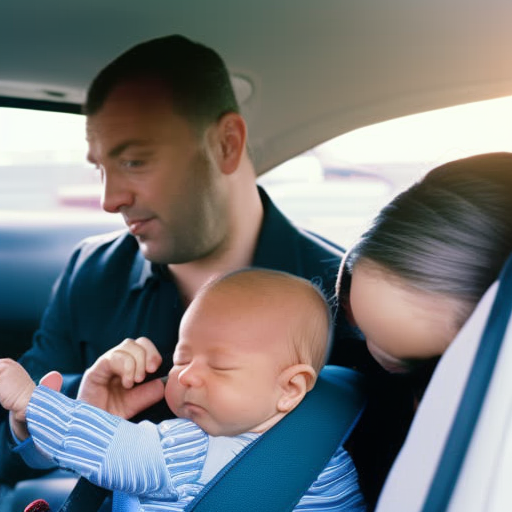
Choosing the right car seat is crucial for the safety and well-being of your newborn. When it comes to car seat safety, there are various factors to consider.
First and foremost, you need to ensure that the car seat is suitable for your baby’s age, weight, and height. A properly fitted car seat will provide optimal protection in the event of a collision.
It is important to choose a car seat that meets all safety standards and regulations. Look for certifications such as the JPMA (Juvenile Products Manufacturers Association) seal of approval or the NHTSA (National Highway Traffic Safety Administration) 5-star rating. These certifications guarantee that the car seat has undergone rigorous testing and meets the necessary safety requirements.
Another aspect to consider is the installation process. Make sure you choose a car seat that’s easy to install correctly, as proper installation is essential for your baby’s safety. Look for features like clear instructions, user-friendly installation systems, and compatibility with your vehicle.
Additionally, consider the overall comfort and convenience of the car seat. Look for features like adjustable straps, padding, and removable covers for easy cleaning. These features not only provide comfort to your newborn but also make your life as a parent much easier.
Age and Weight Recommendations

Your newborn’s age and weight will determine the appropriate car seat for their safety. It’s important to choose a car seat that fits your baby’s size and age to ensure maximum protection while traveling. Here are some age recommendations and weight limits to keep in mind when selecting a car seat for your newborn:
-
Infant Car Seat: This type of car seat is suitable for newborns up to around 1 year old or until they reach the weight limit specified by the manufacturer, usually around 22 pounds. These seats are rear-facing and provide excellent support for your baby’s fragile neck and spine.
-
Convertible Car Seat: Convertible car seats are designed to accommodate both infants and toddlers. They can be used in a rear-facing position for infants up to 2 to 3 years old, depending on their weight and height. Once your child outgrows the rear-facing position, the seat can be converted to a forward-facing position.
-
All-in-One Car Seat: All-in-one car seats are versatile and can be used from infancy through the toddler years. They can be used in a rear-facing position for newborns and then converted to a forward-facing position as your child grows. Some models even have the option to convert into a booster seat for older children.
-
Booster Seat: Booster seats are suitable for children who’ve outgrown their forward-facing car seats. They’re designed to position the seat belt correctly over your child’s body, providing them with the necessary protection until they’re ready for a regular seat belt.
-
Weight Limits: It’s crucial to pay attention to the weight limits specified by the car seat manufacturer. Once your child exceeds the weight limit, it’s time to transition to the next appropriate car seat.
Rear-Facing Vs. Forward-Facing Seats
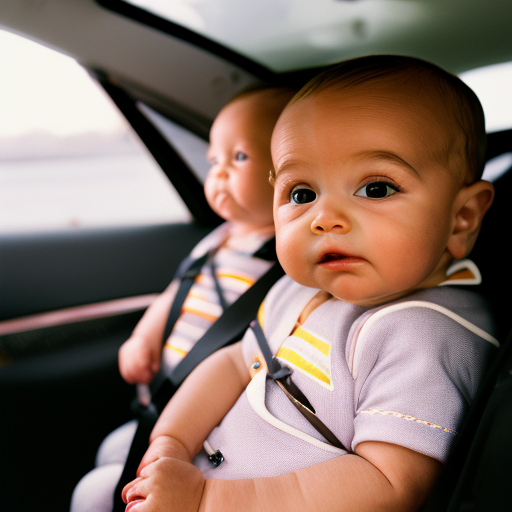
To ensure the safety of your newborn while traveling in a car, it’s important to understand the differences between rear-facing and forward-facing seats.
Rear-facing seats have numerous benefits for your baby. They provide optimal protection for their fragile neck and spine, reducing the risk of injury in the event of a crash. The seat cradles their body, distributing the force of impact evenly and minimizing the strain on their underdeveloped muscles. It also keeps their head, neck, and spine aligned, preventing whiplash and other serious injuries. Rear-facing seats are designed to absorb and dissipate the energy from a collision, providing a cocoon of safety for your little one.
On the other hand, forward-facing seats come with certain risks for newborns. Their neck and spine are still developing, and the impact of a crash can cause severe injuries. In a forward-facing seat, the force of the collision is concentrated on their underdeveloped neck and spine, increasing the risk of injury. Their head is thrown forward, potentially leading to whiplash or even head trauma. Additionally, their limbs aren’t yet strong enough to brace themselves during a crash in a forward-facing seat.
Considering the benefits of rear-facing seats and the risks associated with forward-facing seats for newborns, it’s clear that rear-facing seats are the safest option for your precious little one. It’s recommended to keep your baby in a rear-facing seat for as long as possible, following the weight and height limits provided by the manufacturer.
Five-Point Harness System
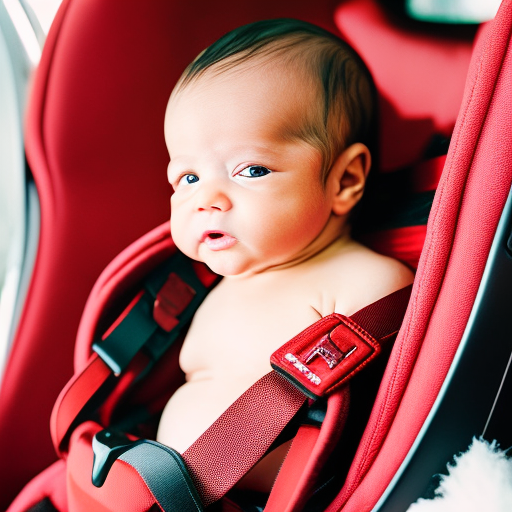
When traveling with your newborn in a rear-facing car seat, it’s essential to understand the benefits of utilizing a five-point harness system. This type of harness consists of adjustable straps that secure your baby at five points: over each shoulder, around each hip, and between the legs.
Here are five reasons why the five-point harness system is the safest option for your little one:
- Enhanced Protection: The five-point harness distributes the force of a crash across your baby’s body, reducing the risk of injury to their delicate neck and spine.
- Secure Fit: The adjustable straps allow you to customize the harness to your baby’s size, ensuring a snug and secure fit every time you travel.
- Easy Buckling: The five-point harness system makes it easy to buckle your baby in and release them quickly when needed.
- Peace of Mind: Knowing that your baby is securely fastened in a five-point harness provides peace of mind during your travels.
- Proper Installation: It’s crucial to learn how to install the car seat properly to maximize the effectiveness of the five-point harness system. Always follow the manufacturer’s instructions and seek professional guidance if needed.
Side-Impact Protection
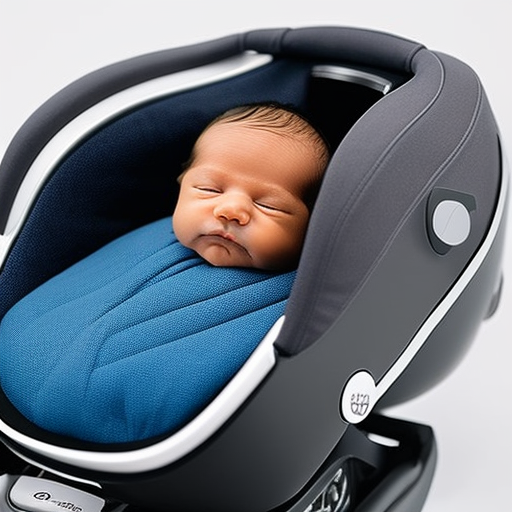
The side-impact protection feature in a car seat further enhances the safety of your newborn during travel. Side-impact crashes can be particularly dangerous for infants, as they can result in serious head and chest injuries. Car seats with advanced side-impact protection are designed to minimize the forces exerted on your baby’s delicate body during a collision from the side.
To ensure the effectiveness of side-impact protection, car seats undergo rigorous side impact testing. These tests simulate real-life crash scenarios and evaluate the car seat’s ability to protect your newborn in such situations. Crash test ratings are assigned based on the performance of the car seat during these tests. The National Highway Traffic Safety Administration (NHTSA) and the Insurance Institute for Highway Safety (IIHS) are two organizations that conduct side impact testing and provide crash test ratings to help parents make informed decisions when purchasing car seats.
The following table summarizes the crash test ratings provided by the NHTSA and IIHS for some popular car seats with side-impact protection:
| Car Seat Model | NHTSA Crash Test Rating | IIHS Crash Test Rating |
|---|---|---|
| Model A | 5 stars | Good |
| Model B | 4 stars | Acceptable |
| Model C | 3 stars | Marginal |
| Model D | 2 stars | Poor |
| Model E | 1 star | Not Recommended |
Choosing a car seat with a high crash test rating in side impact testing can significantly reduce the risk of injury to your newborn in the event of a side-impact collision. It is essential to prioritize the safety of your little one during travel, and investing in a car seat with reliable side-impact protection is a crucial step in ensuring their well-being.
Easy Installation Features
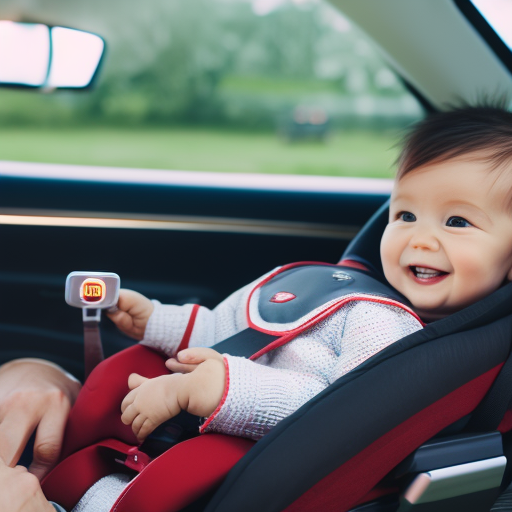
Installing a car seat for your newborn can be made easier with the inclusion of convenient features. When it comes to easy installation, car seats equipped with the LATCH system are highly recommended. Here are five essential features that can simplify the installation process and ensure your newborn’s safety:
-
LATCH system: Look for a car seat that comes with the LATCH (Lower Anchors and Tethers for Children) system. This system uses built-in anchors and tethers in your vehicle to securely attach the car seat, eliminating the need for seat belts.
-
One-hand adjustable straps: Choose a car seat with one-hand adjustable straps that allow you to tighten or loosen the harness effortlessly. This feature saves time and ensures a secure fit for your newborn.
-
Clear and intuitive instructions: Opt for a car seat that provides clear and intuitive instructions, making it easier for you to understand the installation process. Look for labels or color-coded indicators that guide you step by step.
-
Level indicators: Look for a car seat with built-in level indicators that help you achieve the correct recline angle. This ensures your newborn’s head and neck are properly supported and reduces the risk of injury in the event of sudden braking or impact.
-
Quick-release buckles: Choose a car seat with quick-release buckles that allow you to easily secure and release your newborn from the car seat without any hassle.
Adjustable Headrest and Harness
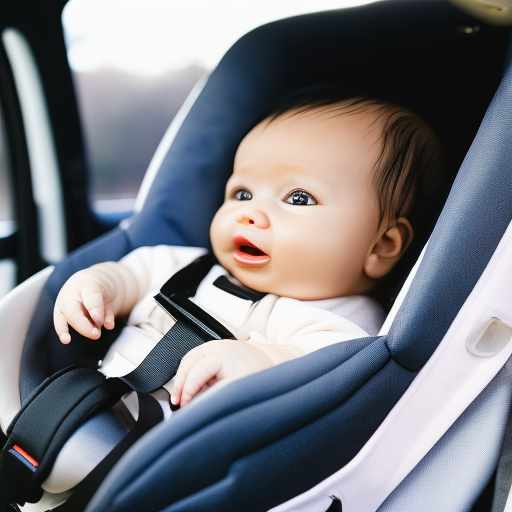
To ensure optimal safety and comfort for your newborn, an adjustable headrest and harness are crucial features to consider when selecting a car seat. These features offer several benefits that contribute to the overall protection and well-being of your baby during car rides.
The adjustable headrest allows you to customize the seat to fit your newborn’s size and height. This ensures proper alignment of the head and neck, reducing the risk of injuries in the event of sudden stops or collisions. As your baby grows, you can easily adjust the headrest to accommodate their changing needs, providing continuous support and protection.
Similarly, the harness plays a vital role in keeping your baby securely in place within the car seat. Look for a car seat with a five-point harness system, which includes two shoulder straps, two waist straps, and one strap between the legs. This design distributes the force of impact evenly across the strongest parts of your baby’s body, minimizing the risk of injury. Additionally, the harness should have adjustable straps to accommodate your baby’s growth and ensure a snug fit.
To help you understand the benefits of an adjustable headrest and the safety features of a harness, here is a table summarizing their importance:
| Adjustable Headrest Benefits | Harness Safety Features |
|---|---|
| Provides customized support | Distributes impact force |
| Ensures proper alignment | Keeps baby securely in place |
| Accommodates growth | Minimizes risk of injury |
Safety Standards and Certifications
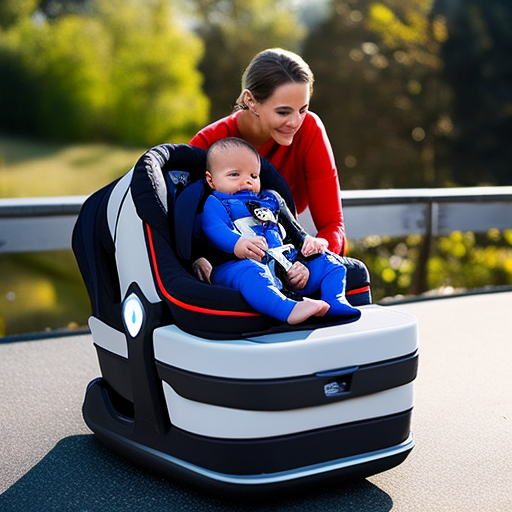
When considering the safety of car seats for your newborn, it’s important to be aware of the various safety standards and certifications that ensure their reliability and effectiveness. These safety regulations and certifications provide reassurance that the car seat you choose meets the necessary safety requirements. Here are five key things to look for:
-
Federal Motor Vehicle Safety Standard (FMVSS) 213: This is the standard that all car seats must meet in the United States. It covers crash testing, restraint system integrity, and labeling requirements.
-
National Highway Traffic Safety Administration (NHTSA) Certification: The NHTSA provides a certification that indicates the car seat has passed rigorous safety testing. Look for the NHTSA label on the car seat.
-
European Safety Standards (ECE R44/04): If you live in Europe, make sure the car seat meets these standards. They cover crash testing, materials used, and labeling.
-
Juvenile Products Manufacturers Association (JPMA) Certification: The JPMA certification ensures that the car seat has been independently tested and meets the highest safety standards.
-
American Academy of Pediatrics (AAP) Recommendations: While not a certification, the AAP provides valuable guidance on car seat safety. Make sure the car seat you choose aligns with their recommendations.
By selecting a car seat that meets these safety standards and certifications, you can have peace of mind knowing that you’re providing the utmost protection for your newborn during car rides.
Remember to always follow the manufacturer’s instructions for installation and use to ensure maximum safety.
Compatibility With Strollers and Travel Systems

Make sure your car seat is compatible with strollers and travel systems by checking the manufacturer’s instructions carefully. Stroller compatibility is an important consideration for parents on the go who want the convenience of easily transferring their newborn from the car to the stroller without disturbing their sleep. Many car seat manufacturers offer stroller compatibility options, allowing you to create a travel system that seamlessly integrates your car seat with a compatible stroller.
When choosing a car seat, look for travel system options that are specifically designed to work together. These travel systems typically include a car seat and a stroller that can be easily attached and detached from each other. The car seat can be clicked into the stroller, eliminating the need to transfer your baby between different seats when you’re out and about.
It’s important to note that not all car seats are compatible with all strollers. Before purchasing a car seat, check the manufacturer’s instructions or website to ensure that it’s compatible with the stroller you plan to use. Some car seats may require an additional adapter to be compatible with certain strollers, so it’s essential to do your research and make sure all the pieces fit together properly.
Having a car seat that’s compatible with strollers and travel systems can make your life as a new parent much easier. It allows for seamless transitions between the car and stroller, ensuring that your baby stays safe and comfortable throughout the journey. So, before making your final decision, be sure to consider the stroller compatibility options available for your chosen car seat.
Cleaning and Maintenance Tips

Keeping your newborn’s car seat clean and well-maintained is essential for their safety and comfort. Here are some cleaning techniques and product recommendations to help you keep your baby’s car seat in top condition:
-
Regular vacuuming: Use a handheld vacuum or brush attachment to remove crumbs, dirt, and debris from the car seat. Pay special attention to crevices and hard-to-reach areas.
-
Spot cleaning: For minor stains, use a mild soap or baby-safe detergent mixed with water. Gently scrub the affected area with a soft cloth or sponge, then wipe it clean with a damp cloth. Avoid using harsh chemicals or bleach.
-
Machine washable covers: Check if your car seat’s cover is machine washable. If it is, follow the manufacturer’s instructions for washing and drying. Use a gentle cycle and mild detergent to avoid damaging the fabric.
-
Harness cleaning: Remove the harness straps from the car seat and wipe them down with a damp cloth. Avoid submerging the straps in water, as this can weaken the material. Let them air dry completely before reattaching.
-
Product recommendations: Look for car seats with removable and washable covers for easier cleaning. Additionally, consider investing in a car seat protector or liner to prevent spills and stains from reaching the seat.
Extended Use and Convertible Options

To ensure your newborn’s safety and comfort as they grow, consider the extended use and convertible options of their car seat.
Convertible options provide a versatile solution that can accommodate your child’s changing needs from infancy to toddlerhood. These car seats are designed to be rear-facing for newborns and can later be converted to forward-facing as your child grows. This extended lifespan ensures that you won’t have to purchase multiple car seats as your baby outgrows their current one.
Convertible car seats typically have higher weight and height limits, allowing your child to use them for a longer period. Many models can accommodate children up to 40 pounds or more, and some even have extended rear-facing capabilities up to 50 pounds. This means your child can remain in the safer rear-facing position for a longer time, providing optimal protection for their head, neck, and spine.
When selecting a convertible car seat, look for one that offers easy installation and adjustments, ensuring a secure fit as your child grows. It’s essential to follow the manufacturer’s guidelines for weight and height limits and to use the car seat in the appropriate configuration (rear-facing or forward-facing) based on your child’s age and size.
Investing in a convertible car seat with extended use options not only provides convenience and cost savings but also prioritizes your child’s safety. With a convertible car seat, you can rest assured that your little one will be protected and comfortable throughout their early years.
User Reviews and Recommendations

Now let’s hear what other parents have to say about their experience with convertible car seats for newborns. Here are some user reviews and recommendations to help you make an informed decision:
-
Graco 4Ever DLX 4 in 1 Car Seat – Many parents rave about the longevity and versatility of this car seat. They appreciate the ease of installation and the comfort it provides for their little ones. The price is higher compared to other options, but the user satisfaction is high.
-
Chicco NextFit Zip Convertible Car Seat – This car seat is praised for its excellent safety features and ease of use. Parents appreciate the simplicity of adjusting the harness and the ability to easily remove the cover for washing. It’s a mid-range option in terms of price.
-
Britax Marathon ClickTight Convertible Car Seat – Users love the ClickTight installation system, which ensures a secure fit every time. The car seat is known for its durability and comfortable padding. While it may be on the higher end of the price spectrum, parents believe it’s worth the investment.
-
Evenflo Symphony Elite All-in-One Convertible Car Seat – This car seat offers great value for the price. Parents appreciate the easy installation process and the ability to adjust the seat as their child grows. The user satisfaction is high due to its safety features and affordability.
-
Safety 1st Grow and Go 3-in-1 Convertible Car Seat – Parents find this car seat to be a budget-friendly option without compromising safety. It’s easy to install and adjust, making it convenient for everyday use. The price is lower compared to other convertible car seats, making it a popular choice among budget-conscious parents.
When considering convertible car seats for newborns, reviewing user recommendations and comparing prices can help ensure you find the best option that meets your needs and provides a safe and comfortable ride for your little one.
Frequently Asked Questions
What Are the Most Important Safety Standards and Certifications to Look for When Choosing a Car Seat for a Newborn?
When choosing a car seat for your newborn, it’s crucial to prioritize safety standards and certifications. Look for side impact protection and opt for a rear-facing seat, which offers advantages in terms of safety.
Can I Use a Car Seat That Is Compatible With a Stroller or Travel System?
Yes, you can use a car seat that is compatible with a stroller or travel system. This provides convenience, as you can easily transfer your baby from car to stroller without disturbing their sleep. When choosing, consider factors like safety, ease of use, and compatibility with your specific stroller or travel system.
What Are Some Easy Installation Features to Consider When Selecting a Car Seat for a Newborn?
When selecting a car seat for your newborn, consider easy installation features like the LATCH system, adjustable base height, and weight limit options. Look for compatibility with different vehicles and make sure it’s easy to buckle and unbuckle.
Are There Any Cleaning and Maintenance Tips Specific to Newborn Car Seats?
To keep your newborn’s car seat squeaky clean, follow these simple cleaning tips and maintenance suggestions. Regularly wipe down the seat with a damp cloth, vacuum the crevices, and check for any loose parts.
What Are Some Extended Use and Convertible Options Available for Newborn Car Seats?
When it comes to newborn car seats, there are extended use options and convertible options available. These allow you to use the car seat as your child grows, ensuring their safety and comfort.
Conclusion
After considering all the important factors and recommendations, it’s clear that choosing the right car seat for your newborn is crucial for their safety and well-being.
The five-point harness system and side-impact protection are essential features to look for.
Additionally, compatibility with strollers and travel systems can provide convenience for parents on the go.
Remember, a safe car seat is like a knight in shining armor, protecting your little one during every journey.


